Centauri Dreams
Imagining and Planning Interstellar Exploration
Fusion Pellets and the ‘Bussard Buzz Bomb’
Fusion runways remind me of the propulsion methods using pellets that have been suggested over the years in the literature. Before the runway concept emerged, the idea of firing pellets at a departing spacecraft was developed by Clifford Singer. Aware of the limitations of chemical propulsion, Singer first studied charged particle beams but quickly realized that the spread of the beam as it travels bedevils the concept. A stream of macro-pellets, each several grams in size, would offer a better collimated ‘beam’ that would vaporize to create a hot plasma thrust when it reaches the spacecraft.

Even a macro-pellet stream does ‘bloom’ over time – i.e., it loses its tight coherency because of collisions with interstellar dust grains – but Singer was able to show through papers in The Journal of the British Interplanetary Society that particles over one gram in weight would be sufficiently massive to minimize this. In any case, collimation could also be ensured by electromagnetic fields sustained by facilities along the route that would measure the particles’ trajectory and adjust it.
Image: Clifford Singer, whose work on pellet propulsion in the late 1970s has led to interesting hybrid concepts involving on-board intelligence and autonomy. Credit: University of Illinois.
Well, it was a big concept. Not only did Singer figure out that it would take a series of these ‘facilities’ spaced 340 AU apart to keep the beam tight (he saw them as being deployed by the spacecraft itself as it accelerated), but it would also take an accelerator 105 kilometers long somewhere in the outer Solar System. That sounds crazy, but pushing concepts forward often means working out what the physics will allow and thus putting the problem into sharper definition. I’ve mentioned before in these pages that we have such a particle accelerator in the form of Jupiter’s magnetic field, which is fully 20,000 times stronger than Earth’s.
We don’t have to build Jupiter, and Mason Peck (Cornell University) has explored how we could use its magnetic field to accelerate thousands of ‘sprites’ – chip-sized spacecraft – to thousands of kilometers per second. Greg Matloff has always said how easy it is to overlook interstellar concepts that are ‘obvious’ once suggested, but it takes that first person to suggest them. Going from Singer’s pellets to Peck’s sprites is a natural progression. Sometimes nature steps in where engineering flinches.
The Singer concept is germane here because the question of fusion runways depends in part upon whether we can lead our departing starship along so precise a trajectory that it will intercept the fuel pellets placed along its route. Gerald Nordley would expand upon Singer’s ideas to produce a particle stream enlivened with artificial intelligence, allowing course correction and ‘awareness’ at the pellet level. Now we have a pellet that is in a sense both propellant and payload, highlighting the options that miniaturization and the growth of AI have provided the interstellar theorist.
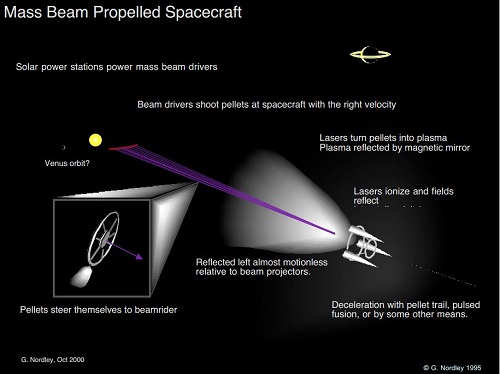
Image: Pushing pellets to a starship, where the resulting plasma is mirrored as thrust. Nordley talks about nanotech-enabled pellets in the shape of snowflakes capable of carrying their own sensors and thrusters, tiny craft that can home in on the starship’s beacon. Problems with beam collimation thus vanish and there is no need for spacecraft maneuvering to stay under power. Credit: Gerald Nordley.
Jordin Kare’s contributions in this realm were striking. A physicist and aerospace engineer, Kare spent years at Lawrence Livermore National Laboratory working on early laser propulsion concepts and, in the 1980s, laser-launch to orbit, which caught the attention of scientists working in the Strategic Defense Initiative. He would go on to become a spacecraft design consultant whose work for the NASA Institute for Advanced Concepts (as it was then called) analyzed laser sail concepts and the best methods for launching such sails using various laser array designs.
Kare saw ‘smart pellets’ in a different light than previous researchers, thinking that the way to accelerate a sail was to miniaturize it and bring it up to a percentage of c close to the beamer. This notion reminds me of the Breakthrough Starshot sail concept, where the meter-class sails are blasted up to 20 percent of lightspeed within minutes by a vast laser array. But Kare would have nothing to do with meter-class sails. His notion was to make the sails tiny, craft them out of artificial diamond (he drew this idea from Robert Forward) and use them not as payload but as propulsion. His ‘SailBeam’, then, is a stream of sails that, like Singer’s pellets, would be vaporized for propulsion as they arrived at a departing interstellar probe.

Kare was a character, to put it mildly. Brilliant at what he studied, he was also a poet well known for his ‘filksongs,’ the science fiction fandom name for SF-inspired poetry, which he would perform at conventions. His sense of humor was as infectious as his optimism. Thus his DIHYAN, a space launch concept involving reusable rockets (if he could only see SpaceX’s boosters returning after launch!). DIHYAN, in typical Kare fashion, stood for “Do I Have Your Attention Now?” Kare’s role in the consideration of macro-scale matter sent for propulsion is secure in the interstellar literature.
And by the way, when I write about Kare, I’m always the recipient of email from well-meaning people who tell me that I’ve misspelled his name. But no, ‘Jordin’ is correct.
We need to talk about SailBeam at greater length one day soon. Kare saw it as “the most engineering-practical way to get up to a tenth of the speed of light.” It makes sense that a mind so charged with ideas should also come up with a fusion runway that drew on his SailBeam thinking. Following on to the work of Al Jackson, Daniel Whitmire and Greg Matloff, Kare saw that if you could place pellets of deuterium and tritium carefully enough, a vehicle initially moving at several hundreds of kilometers per second would begin encountering them with enough velocity to fire up its engines. He presented the idea at a Jet Propulsion Laboratory workshop in the late 1980s.
We’re talking about an unusual craft, and it’s one that will resonate not only with Johndale Solem’s Medusa, which we’ll examine in the next post, but also with the design shown in the Netflix version of Liu Cixin’s The Three Body Problem. This was not the sleek design familiar from cinema starships but a vehicle shaped more or less like a doughnut, although a cylindrical design was also possible. Each craft would have its own fusion pellet supply, dropping a pellet into the central ‘hole’ as one of the fusion runway pellets was about to be encountered. Kare worked out a runway that would produce fusion explosions at the rate of thirty per second.
Like Gerald Nordley, Kare worried about accuracy, because each of the runway pellets has to make a precise encounter with the pellet offered up by the starship. When I interviewed him many years back, he told me that he envisioned laser pulses guiding ‘smart’ pellets. Figure that you can extract 500 kilometers per second from a close solar pass to get the spacecraft moving outward at sufficient velocity (a very optimistic assumption, relying on materials technologies that are beyond our grasp at the moment, among other things), and you have the fusion runway ahead of you.
Initial velocity is problematic. Kare believed the vehicle would need to be moving at several hundreds of kilometers per second to attain sufficient velocity to begin firing up its main engines as it encountered the runway of fusion pellets. Geoff Landis would tell me he thought the figure was far too low to achieve deuterium/tritium ignition. But if it can be attained, Kare’s calculations produced velocities of 30,000 kilometers per second, fully one-tenth the speed of light. The fusion runway would extend about half a light day in length, and the track would run from near Earth to beyond Pluto’s orbit.
And there you have the Bussard Buzz Bomb, as Kare styled it. The reference is of course to the German V-1, which made a buzzing, staccato sound as it moved through English skies that those who heard it would come to dread, because when the sound stopped, you never knew where it would fall. You can’t hear anything in space, but if you could, Kare told me, his starship design would sound much like the V-1, hence the name.
In my next post, I’ll be talking about Johndale Solem’s Medusa design, which uses nuclear pulse propulsion in combination with a sail in startling ways. Medusa didn’t rely on a fusion runway, but the coupling of this technology with a runway is what started our discussion. The Netflix ‘3 Body Problem’ raised more than a few eyebrows. I’m not the only one surprised to see the wedding of nuclear pulse propulsion, sails and runways in a single design.
Clifford Singer’s key paper is “Interstellar Propulsion Using a Pellet Stream for Momentum Transfer,” JBIS 33 (1980), pp. 107-115. He followed this up with “Questions Concerning Pellet-Stream Propulsion,” JBIS 34 (1981), pp. 117-119. Gerald Nordley’s “Interstellar Probes Propelled by Self-steering Momentum Transfer Particles” (IAA-01-IAA.4.1.05, 52nd International Astronautical Congress, Toulouse, France, 1-5 Oct 2001) offers his take on self-guided pellets. Jordin Kare’s report on SailBeam concepts is “High-Acceleration Micro-Scale Laser Sails for Interstellar Propulsion,” Final Report, NIAC Research Grant #07600-070, revised February 15, 2002 and available here. You might also enjoy my SailBeam: A Conversation with Jordin Kare.

The Interstellar Fusion Runway Evolves
Let’s talk about how to get a spacecraft moving without onboard propellant. As noted last week, this is apropos of the design shown in the Netflix streaming video take on Liu Cixin’s novels, which the network titles ‘3 Body Problem.’ There, a kind of ‘runway’ is conceived, one made up of nuclear weapons that go off in sequence to propel a sail and its payload. The plan is to attain 0.012 c and reach an oncoming fleet that is headed to Earth but will not arrive for another four centuries.
This is an intriguing notion, and one with echoes in the interstellar literature. Because Johndale Solem mixed sails and nuclear weapons in a design called ‘Medusa’ that he described in a Los Alamos report back in 1991, although its roots go back decades earlier, as I’ll discuss in an upcoming article. Mixing sails, nuclear weapons and a fusion runway is an unusual take, a hybrid concept that caught my eye immediately, as it did that of Al Jackson, who alluded to runways in a paper in the 1970s. I’ve just become aware of a Greg Matloff paper from 1979 on runways as well.
So let’s start with the runway concept and in subsequent posts, I will be looking at how Medusa evolved and consider whether the hybrid concept of ‘3 Body Problem’ is worth pursuing. Jackson’s paper, written with Daniel Whitmire, is one we’ve considered before in these pages. The concept is to power up a starship by a laser but use reaction mass gathered from the interstellar medium, collecting the latter with a ramscoop. Here the model draws on Robert Bussard’s ramjet notions, originally published in 1960 and more or less immortalized in Poul Anderson’s novel Tau Zero. Jackson and Whitmire’s version was one of several variants on Bussard’s original concept and offered a number of performance benefits.
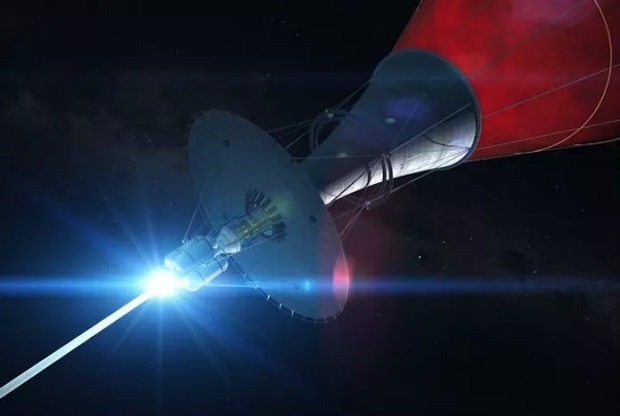
Image: The interstellar ramjet, as envisioned by British artist Adrian Mann. Variants have appeared in the literature to get around the drag issue induced by the ramscoop design. A fusion runway seeds fuel along a track that the craft follows as it accelerates.
You’ll notice that this is also a hybrid concept, combining ramjet capabilities with laser beaming. Lasers had already been considered for beaming a terrestrial or Solar System-based laser at the departing craft, which could deploy a lightsail to draw momentum from the incoming photons. Jackson and Whitmire found the latter method inefficient. Their solution was to beam the laser at a ramjet that would use reaction mass obtained from a Bussard-style magnetic ram scoop. The ramjet uses the laser beam as a source of energy but, unlike the sail, not as a source of momentum.
Jackson and Whitmire were a potent team, and this is one of their best papers. These methods could be used to reach 0.14 c, allowing the vehicle to switch into full ramjet mode at that point. And because the laser is a source of energy rather than momentum, it can also be used as a means to decelerate on the return trip. For our purposes today, I turn to the last part of the paper, which outlines other starship concepts that grow out of the laser beaming analysis. Here is the relevant passage:
Another possibility would be to artificially make a fusion ramjet runway. Micron-size frozen deuterium pellets could be accelerated electrostatically or electromagnetically beginning several years prior to take-off at which time a fusion ramjet with a relatively modest scoop cross section (perhaps a physical structure) would begin acceleration.
So we have a spacecraft that collects its fuel along the way. As opposed to the ‘pure’ ramjet, which scoops up interstellar material and is dependent on the medium through which it moves, this fusion runway ramjet would know exactly the trajectory to take to collect the needed fuel pellets as it accelerates. Bear in mind the original Bussard ramjet problem of having to reach a certain percentage of lightspeed before being able to ignite its fusion engine. Problem solved.
In recent correspondence, Jackson pointed out that the idea harkens back to the German Vergeltungswaffe 3 (“Vengeance Weapon 3”), which was a gun originally designed to bombard London but only saw use against Allied targets in Luxembourg in 1945 (the bunkers at the Pas-de-Calais were destroyed by bombing raids). Multiple solid-fuel rocket boosters were ignited by the gases pushing the projectile as it moved in staged fashion through the barrel. The French Army had considered plans for such a staged cannon as far back as 1918, and the idea dates to the 19th Century.

Image: The prototype V-3 cannon at Laatzig, Germany (now Zalesie, Poland) in 1942. Credit: Bundesarchiv, Bild 146-1981-147-30A / CC-BY-SA 3.0.
Greg Matloff picked up on the Jackson and Whitmire paper in a 1979 paper in The Journal of the British Interplanetary Society which he was kind enough to pass along to me. The Jackson/Whitmire fusion runway would, he believed, improve ramjet performance and alleviate aerodynamic drag, which is a problem that sharply reduces a Bussard vehicle’s acceleration. He considered in the paper a fusion fuel released as fuel pellets moving in the direction of the destination star, with the ramjet moving up from behind to capture and fuse the pellets. In one scenario, tanker craft would be launched over a 50 year period to produce a runway 0.1 light years long.
Matloff as well as Jackson and Whitmire considered other variations on the interstellar ramjet idea, and I want to just mention these before moving on. From the Matloff paper:
As Whitmire and Jackson have mentioned, the performance of a ramjet might be of interest just above the photosphere of the Sun, n a high-energy, high-particle environment. More prosaically, a ramscoop could be utilized near the Earth to collect fusion fuel from the solar wind over a few decades. Then, if the fuel is utilized to power a ram-augmented interstellar rocket (RAIR), such an approach might be competitive in any discussion of the difficulties and merits of the various ramjet derivatives.
A Sun-skimming ramjet is one I had never seen discussed until I read Jackson and Whitmire. It would make for a lively hard SF tale, that’s for sure. Given the problems with ramjet drag that have been wrestled with in the subsequent literature, it’s worth considering Matloff’s idea of solar wind fuel collection at much lower speeds in the inner system. In any case, the fusion runway notion offers one way to collect a known supply of fuel over the length of a runway that would launch an interstellar craft.
When I wrote my Centauri Dreams book early in the century, I was unaware of both the papers we’ve looked at today, and focused on the only runway concept that was then known to me, the so-called ‘Bussard Buzz Bomb’ of the free-thinking Jordin Kare. Kare is, alas, no longer with us, but I enjoyed a long conversation with him on his runway concept, and I want to cover that in the next post before moving on to Johndale Solem’s Medusa.
The Jackson/Whitmire paper on laser-powered ramjets is “Laser Powered Interstellar Ramjet,” Journal of the British Interplanetary Society Vol. 30 (1977), 223-226. Al Jackson: A Laser Ramjet Reminiscence presents Al’s thoughts on this paper as written for this site. Greg Matloff’s paper on fusion runways is “The Interstellar Ramjet Acceleration Runway,” JBIS Vol. 32 (1979), 219-220. The ToughSF site offers a detailed explanation of runway concepts in Fusion Highways in Space.

Interstellar Propulsion in ‘3 Body Problem’
You never know when a new interstellar propulsion concept is going to pop up. Some of us have been kicking around fusion runway ideas, motivated by Netflix’s streaming presentation of the Liu Cixin novel The Three Body Problem. There Earth is faced with invasion from an extraterrestrial civilization, but with centuries to solve the problem because it will take that long for the fleet to arrive. Faced with the need to get as much information as possible about the invaders, scientists desperately search for a way to get human technology up to 1.2 percent of lightspeed to intercept the fleet.
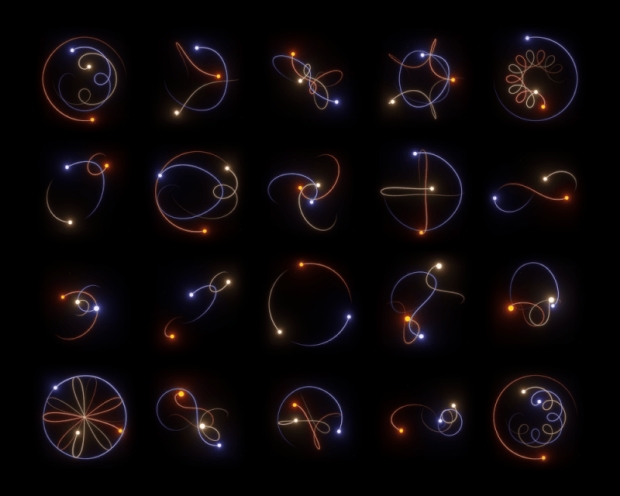
Image: 20 different examples of periodic solutions to the three body problem. Credit: Perosello/Wikimedia Commons. CC BY-SA 4.0.
So how would you do that with technology not much more advanced than today’s? The Netflix show’s solution is ingenious, though confusing for those who assume that the Netflix ‘3 Body Problem’ is based solely on the first of the Cixin novels. Actually it edges into the rest of the trilogy, which includes 2008’s The Dark Forest and 2010’s Death’s End. The whole sequence is known as Remembrance of Earth’s Past, and I had to dig into not just The Three Body Problem but The Dark Forest to find much discussion of any kind of propulsion.
Now we’re in a dark wood indeed. For in The Dark Forest (the title is an allusion to the Fermi paradox, usually linked with concerns over METI), the idea of a precursor scouting of the alien invasion fleet does not appear, nor does it appear in the first novel. What we do get is a lot of confusing discussion, such as this:
“If controlled nuclear fusion is achieved, spacecraft research will begin immediately. Doctor, you know about the two current research forks: media-propelled spacecraft and non-media radiation-drive spacecraft. Two opposing factions have formed around these two directions of research: the aerospace faction advocates research into media-propelled spacecraft, while the space force is pushing radiation-drive spacecraft… The fusion people and I are in favor of the radiation drive. For my part, I feel that it’s the only plan that enables interstellar cosmic voyages.”
The book’s many references to a ‘radiation drive’ seem to be referring to antimatter. What Cixin calls ‘media-propelled spacecraft’ is opaque to me, and I’d welcome reader comments on what it represents. Then there is a ‘curvature drive’ that appears in the final volume of the trilogy, but let’s leave that out of the discussion today. Perhaps it’s a kind of Alcubierre concept, but in any case I want to focus on fusion runways and sails for now, because the Netflix eight-part video presents the idea of sending a relatively small payload toward the invasion fleet using a form of nuclear pulse propulsion.
Here the presentation is accurate if rudimentary but the idea is fascinating. Because I don’t find this in the novels, I am wondering about where, along the route to production, the show acquired a technology made famous originally by Project Orion, with its sequence of nuclear explosions visualized as occurring behind a spacecraft’s huge shock absorbers. Wonderfully, the idea opens up to multiple interstellar propulsion ideas in the literature, including Johndale Solem’s Medusa concept and various fusion runway notions that emerged decades ago, one by my friend Al Jackson and Daniel Whitmire, another by Jordin Kare, who christened his concept the ‘Bussard buzz bomb.’
So we’ve got a lot to talk about. And out of the blue Adam Crowl wrote to remind me of something Martyn Fogg pointed out in 2017, when I wrote about Medusa then. Here’s Martyn’s comment:
Suppose these Solem sails were to have a small hole in their centre, they could be steered accurately, and that nuclear propulsion charges could be lined up perfectly in space, perhaps by laser guidance. Then one might imagine an ‘Interstellar Solem Sail Runway’ which would impart a jolt of pulse propulsion each time its sail overtook each charge, thereby accelerating the outgoing ship as a whole up to interstellar cruse velocity. The vessel would only need fuel to decelerate at the target system: a considerable reduction in the mass it would need to carry.
Talk about prescient! Because this is what shows up on the Netflix series.
I’m slammed for time this morning and have way too many ideas floating around as well as tabs open in various screens, so I’m going to break here and pick up this discussion next week, when I want to get into the details of fusion runways, and then I want to relate all this to Solem’s Medusa work by way of illustrating not only how ingenious all these ideas are, but how striking the design in the screen version of the Three Body Problem turns out to be. The designs we’ll be discussing are some of the most innovative that have come out of the interstellar effort thus far.

Deep Space Trajectories: Exiting the Heliosphere
Eugene Parker, after whom the Parker Solar Probe was named, seems to have been the first to have accurately predicted the stream of particles emitted by the Sun that forms the ‘solar wind.’ Parker made the call in a 1958 paper, when solar sailing was just being noised about for the first time, so it wouldn’t have struck him that the term was a bit incautious. Today, when solar sailing is operational, people often assume the solar wind drives solar sails, when in fact the operating principle for solar sails is the momentum generated by photons, which are themselves massless. But streaming particles are indeed a kind of ‘wind,’ and there are magnetic sail concepts tailored for them too.
As always, we have to be careful about terminology, especially given the significance of the solar wind in defining our Solar System’s environment. Solar transients likewise have to be considered, because in addition to solar flares, we have to factor in coronal mass ejections (CMEs) and the particles accelerated by both of these. All of this as well as the interplanetary magnetic field shapes our star’s interactions with the local interstellar medium, creating the plasma envelope called the heliosphere. Only the Voyager spacecraft have returned data from the LISM, and they’re not very far into it.
We’ve looked at the Interstellar Probe concept in these pages before. The result of countless hours and numerous contributors at the Johns Hopkins Applied Physics Laboratory and elsewhere, the study was created for the Solar and Space Physics Decadal Survey and extensively analyzes everything from the launch vehicle to instrumentation for a mission that would exit the heliosphere and reach as far as hundreds of AUs within 50 years. Given that our knowledge of the realm beyond the heliosphere is almost entirely the result of remote sensing and indirect measurements, having an actual spacecraft on the scene would take us far beyond our modeling.
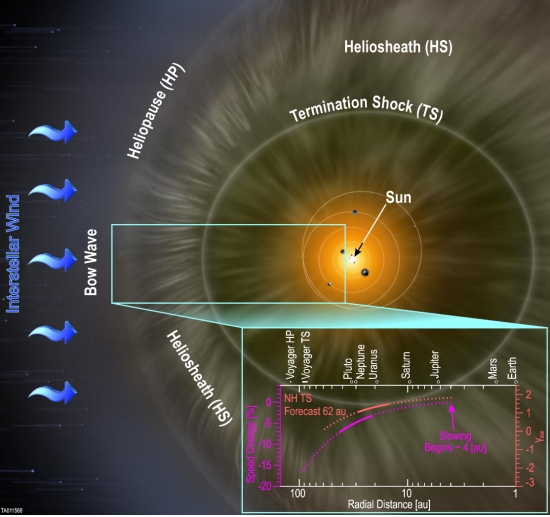
Image: The SWAP instrument aboard New Horizons has confirmed that the solar wind slows as it travels farther from the Sun. This schematic of the heliosphere shows that the solar wind begins slowing at approximately 4 AU radial distance from the Sun and continues to slow as it moves toward the outer solar system and picks up interstellar material. Current extrapolations reveal the termination shock may currently be closer than found by the Voyager spacecraft. However, increasing solar activity will soon expand the heliosphere and push the termination shock farther out, possibly to the 84-94 AU range encountered by the Voyager spacecraft. Credit: Southwest Research Institute; background artist rendering by NASA and Adler Planetarium.
Because I’m talking about the outer boundaries of the heliosphere today, a quick word about how remote sensing ‘sees’ them is appropriate. We have data from the IBEX satellite (Interstellar Boundary Explorer) covering an entire solar cycle from 2009 through 2019. Although it’s in Earth orbit, IBEX detects energetic neutral atoms (ENAs) from the outer regions of the heliosphere, the zone where solar wind particles begin to collide with those of the even less understood interstellar wind. We are in essence mapping a region by sending a signal – actually using the Sun’s ‘signal,’ the particles of the solar wind – deep into the edge of the system and trying to make sense out of the return echoes. The IMAP (Interstellar Mapping and Acceleration Probe), set for launch in 2025, will further examine this region from its own vantage at the L1 Lagrange point.
We can draw a lot of conclusions from the data from such missions, but not enough. Sarah Spitzer (University of Michigan), lead author of a paper on a just released study that analyzes how best to exit the heliosphere, notes the significance of the JHU/APL work: “Without such a mission, we are like goldfish trying to understand the fishbowl from the inside.”
Indeed. Considered as a kind of shield, the heliosphere acts as a brake on galactic radiation, but predicting its effects, and even more significantly its shape and size over time, is all but impossible. We tend to refer to the heliosphere as a ‘bubble,’ but it’s a poor term given that the shape changes with solar output and interactions with the LISM. A variety of potential shapes for the heliosphere remain in play in the literature. Have a look at the figure below, which represents just one of the numerous possibilities.
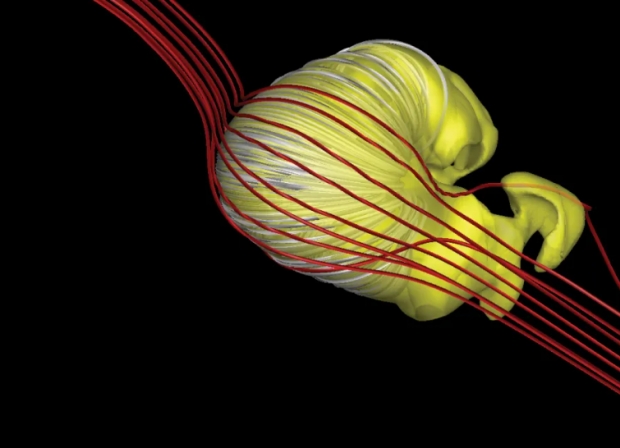
Image: One recent study of the heliosphere’s shape posited a croissant-shape or small spherical shape with tail lobes. Credit: Figure adapted from Merav Opher et al., 2020.
As Spitzer and colleagues note:
Small variations in model parameters and properties measured in the nose of the heliosphere, the leading edge in the direction of the Sun’s motion through the LISM, lead to significant differences in the projected shape. The global response of the heliosphere is additionally expected to fluctuate with solar activity and therefore solar cycle…, which is yet another element in the interplay of heliosphere–interstellar interactions and another factor in our uncertainty of the overall shape. The main features of the shape of the heliosphere include the nose; the tail, which can be defined relative to the Sun as the region of the heliosphere found in the direction opposite the Sun’s motion through the LISM; the size of the heliosphere; and the behavior of the magnetic field lines at the heliospheric boundaries. All of these properties, including the size of the heliosphere, vary vastly in different proposed shapes and models of the heliosphere, which range in size anywhere from hundreds to thousands of au and in shape from comet- or magnetosphere-like or otherwise with extended tails… to spherical to croissant-shaped with multiple tail lobes…
Bear in mind that the heliosphere is a moving target. As recently as 60,000 years ago, the Sun entered what is called the Local Interstellar Cloud, and is now considered to be at that cloud’s edge or perhaps beyond it and in contact with surrounding clouds. The JHU/APL Interstellar Probe study notes that within 2000 years, our system will likely be within a completely different interstellar environment. The heliosphere will adjust. Let me quote the Interstellar Probe report on this, because the effects are startling when we consider the Sun’s 20 revolutions around the galactic core since its formation:
The orders-of-magnitude differences in interstellar properties have had dramatic consequences for the penetration of interstellar gas, dust, and galactic cosmic rays (GCRs) that have affected elemental and isotopic abundances, chemical atmospheric evolution, and perhaps even biological evolution. Along the evolutionary path, high interstellar cloud densities and ionization fractions have likely compressed the heliosphere down to below 25 au… Evidence is emerging for supernovae explosions as recent as 3 million years ago at only 20–50 pc from the Sun that probably compressed the heliosphere even below the orbit of Saturn and perhaps more, exposing the terrestrial planets to almost the full force of interstellar material and GCRs…
The GCR’s referenced above are galactic cosmic rays, high energy particles and heavy nuclei that can prove lethal to biology. The shielding effects of the heliosphere are all too easy to take for granted until we consider its malleable nature, so the more we learn about what affects it the better. The JHU/APL work highlights a probe trajectory that will not only sample the local interstellar medium but give us the ‘look back’ capability to see it as a whole, with the probe exiting the heliosphere at approximately 45 degrees off the heliopause nose direction.
This trajectory is attractive because it allows the heliopause and local interstellar medium to be reached within a reasonable timeframe, which in this context means something less than 50 years with current propulsion technologies. It also offers what the authors call “somewhat of a side view of the heliopause,” though one in the direction of the nose, and it allows the IBEX ribbon, a still puzzling region of enhanced Energetic Neutral Atom (ENA) emission in the outer heliosphere, to be probed.
But a trajectory through the IBEX ribbon center is only one of those that Spitzer and team analyze, ranging from the heliosphere nose to various angles out of the heliotail, the trailing part of the heliosphere in relation to the Sun’s motion through the medium. Here again I’m reminded of how little we know of the heliosphere’s shape, for some estimates of the heliotail have it extending more than 5000 AU downwind of the Sun. Hence the value of this paper, which assembles what our indirect observing methods have so far produced by way of data on the various defined parts of the heliosphere.
To facilitate mission planning, the paper proposes continued indirect measurements of ENA and the pickup ions (PUI) that facilitate a stronger ENA flux, emphasizing the heliotail, and measurements of interstellar ions that penetrate the heliosphere, including cosmic rays in the heliotail region. For the in situ measurements, the authors point out that the largest differences between the suggested shapes of the heliosphere would appear in the tail region. Our probe would thus do best to exit through the side of the heliosphere’s tail. Better still, the authors say, would be a two-spacecraft Interstellar Probe mission option reminiscent of the twin Voyager missions, one moving toward the nose, the other in the direction of the heliotail.
A great idea, but try to get that through the various funding entities… Even so:
Only a study of the tailward region of the heliosphere will give definitive evidence for the complete shape, which impacts how the heliosphere interacts with the LISM and therefore how the LISM impacts the composition of the heliosphere. Therefore, complementary in situ and indirect interstellar measurements must be made tailward within the heliosphere. These measurements can be made through the use of intentional instrumentation requirements for outer heliosphere missions. Additionally, it would be beneficial for the Interstellar Probe mission to either consider a trajectory through the heliotail, via the flank, or to comprise a unified mission of two spacecraft, in which a second Interstellar Probe would be launched with a tailward trajectory, perhaps intersecting one of the proposed…tail lobes.
The paper is Spitzer et al, “Complementary interstellar detections from the heliotail,” Frontiers in Astronomy and Space Sciences (08 February 2024). Full text.

A Week Inside Centauri Dreams
No posts this week, as I am wrapping up an overhaul of some of the site’s internals. When I say ‘I,’ I really mean my brilliant web guru, whose team has worked tirelessly to fix a major problem with the archives. The problem has to do with special characters of the sort used often in scientific papers. An upgrade to the site software some months back caused many of these to render improperly, and fixing what seemed a simple issue has proven extraordinarily complex. As best I can tell, we now have about 85 percent of the problem solved, and the changes will be implemented in a few days. After that, I will be identifying and fixing the remainder one by one. There are reasons for the baroque nature of this procedure, but they’re too complicated to explain here. Please keep the comments coming, as I’ll continue to moderate them as these changes are being put into place.

Finding Life Signs around Icy Moons
Europa Clipper is scheduled to launch on October 10, with arrival at Jupiter in 2030. That will keep subsurface oceans on our minds as we tangle with the problems of analyzing water locked under kilometers of ice. Some moons, of course, help us out. Enceladus spews watery materials into space through cracks in its crust, making flybys through its geysers a possibility for snagging samples. Europa Clipper may find further evidence of the much less dramatic plume activity that has been spotted on Europa. Clipper’s SUrface Dust Analyzer (SUDA) would prove vital in such analysis.
If cellular material is found in an ice grain snared from an orbital pass, would we be able to detect it? The answer may be found in laboratory work with a common bacteria that thrives in the waters off Alaska. As explained in new work out of the University of Washington and the Freie Universität Berlin, the bacterium Sphingopyxis alaskensis is made to order for such studies. It is smaller than Escherichia coli (frequently used in experimental work), thrives in cold conditions and needs little by way of nutrients to stay alive. If you want to approximate an icy moon’s ocean environment and experiment here with how life might operate there, Sphingopyxis alaskensis is just the ticket.
Under the direction of lead author Fabian Klenner (University of Washington), a research team has been pondering how material ejected from a moon like Enceladus might be detected by a spacecraft passing through a plume. The benefits of analyzing materials from subsurface oceans without landing are obvious, although Enceladus presents a much more benign environment for surface investigation than Europa, given the vents in its south polar crust and its much lower radiation exposure. And even if you find a way to shield a Europa lander, how to drill through all that ice?
The challenge the team has overcome is how to simulate ice grains impacting a scientific instrument at between four and six kilometers per second. The proposed solution: Fire a beam of liquid water into a vacuum. As it transforms into droplets, deploy a laser beam to excite the droplets and subject the result to mass spectral analysis, which identifies chemical and isotopic compositions. Europa Clipper’s SUrface Dust Analyzer will be able to detect ions with negative charges, even fatty acids and lipids. Thus the prospect of flying through a Europan plume looms as an exciting astrobiological possibility.
The genesis of this work comes from the authors’ analysis of Enceladus, in which they examined the evidence for phosphates in its ocean. The moon appears to contain the organic materials and the energy resources needed to support some form of life. Indeed, that work, developed in a 2023 paper, found that phosphate is present in the Enceladus ocean at levels at least 100 times higher, and perhaps much higher still, than in Earth’s oceans. Phosphates are vital to life on Earth, and this work was the first report of direct evidence of phosphorus on an icy moon. As Klenner noted then:
“By determining such high phosphate concentrations readily available in Enceladus’ ocean, we have now satisfied what is generally considered one of the strictest requirements in establishing whether celestial bodies are habitable.”
So we have an ocean laden with recently discovered dissolved phosphates, one with previously known dissolved carbonates and a variety of other carbon-containing compounds and salts. Bacterial cells found here, if encased in a liquid membrane, might well rise through cracks in the ice shell even as exposure to the vacuum would cause the waters directly below to boil. Gas bubbles bursting at the surface would allow cellular material to become incorporated into ice grains being blown outward by the plume. That’s a scenario that makes for possible life discovery.
As the paper notes:
Although an extraterrestrial biosphere might use different biochemistry, it is logical to assume an aqueous-based ecosystem with access to molecular building blocks common in our Solar System [e.g., amino acids, aliphatic hydrocarbons, sugars, nitrogen heterocycles, and others commonly found in meteorites (69)] would likely use and modify the concentrations of those molecules in ways that would deviate from an abiotic system (57, 70).

Image: The left panel shows the kilometers-thick icy crust believed to encapsulate Saturn’s moon Enceladus. Filling the crack is salty water with a proposed thin layer (shown orange) at its surface. The right panel shows that as gas bubbles rise and pop, they combine with organic material and get lofted into the spray. Credit: Postberg et al. (2018)/Nature.
The experimental results in the recent lab work on Sphingopyxis alaskensis are encouraging. The above mechanism would produce enough material in individual ice grains for cellular matter to be detected by instruments like those aboard Europa Clipper and future missions to icy moons. Indeed, a single ice grain would do the trick. Says Klenner:
“For the first time we have shown that even a tiny fraction of cellular material could be identified by a mass spectrometer onboard a spacecraft. Our results give us more confidence that using upcoming instruments, we will be able to detect lifeforms similar to those on Earth, which we increasingly believe could be present on ocean-bearing moons.”
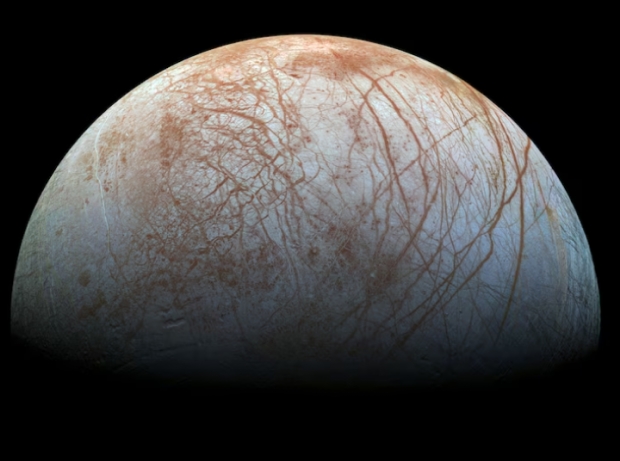
Image: Won’t it be great when we can move past the old Galileo imagery of Europa for fresh images taken by Europa Clipper? This Galileo image shows red streaks across the surface of this smallest of Jupiter’s four large moons. New research shows that one of the instruments destined for the Clipper mission could find traces of a single cell in a single ice grain ejected from the moon’s interior. Credit: NASA/JPL/Galileo.
The paper is Klenner et al., “How to identify cell material in a single ice grain emitted from Enceladus or Europa,” Science Advances, Vol 10, Issue 12 (22 March 2024). Abstract. The paper on phosphates on Enceladus is Postberg et al., “Detection of phosphates originating from Enceladus’s ocean,” Nature 618 (14 June 2023) 489-493 (abstract).


